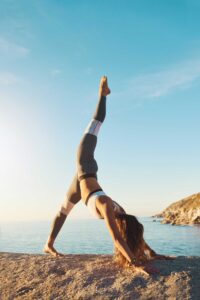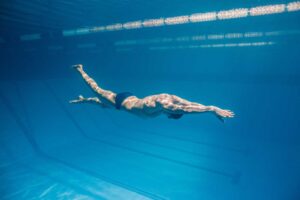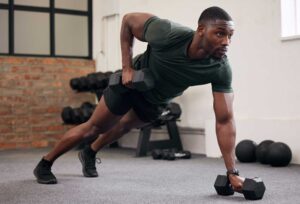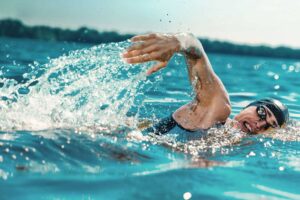Swimming is one of the most physically demanding sports, requiring athletes to balance strength, power, endurance, and flexibility. While regular training builds these skills, recovery is equally critical to prevent injuries and ensure long-term performance. Recovery exercises for swimmers help in muscle repair and enhance overall mobility, strength, and resilience. Here, we’ll explore five proven techniques to help swimmers recover effectively and prevent injuries.
1. Dynamic Stretching for Improved Flexibility
Dynamic stretching is an excellent way for swimmers to maintain flexibility while promoting muscle blood flow after intense training sessions. Unlike static stretching, dynamic stretches involve controlled movements through a full range of motion, helping to loosen tight muscles and improve joint mobility.
Recommended Dynamic Stretches for Swimmers:
· Arm Circles: Perform forward and backward arm circles to target shoulders and rotator cuffs.
· Leg Swings: Swing each leg forward and backward to loosen hip flexors and hamstrings.
· Trunk Twists: Rotate your torso from side to side to improve spinal flexibility and core engagement.
Incorporating dynamic stretching into your post-swim routine can reduce muscle stiffness and improve recovery time, ultimately preventing overuse injuries.

2. Foam Rolling for Myofascial Release
Foam rolling is a self-massage technique that targets knots and tight spots in your muscles, also known as trigger points. It is particularly beneficial for swimmers who often experience tightness in their shoulders, back, and legs due to repetitive movements in the water.
Foam Rolling Tips:
· Focus on Key Areas: Roll over your shoulders, lats, calves, and quads, spending about 30 seconds on each area.
· Apply Gentle Pressure: Avoid rolling directly over joints or applying excessive pressure, which can cause discomfort or bruising.
· Use Post-Workout: Foam rolling immediately after training can help alleviate muscle soreness and improve circulation.
Regular foam rolling not only aids recovery but also enhances flexibility and reduces the risk of muscle imbalances, common culprits of swimmer injuries.
3. Core Strengthening to Stabilize Movement
A strong core is essential for swimmers to hold a taut bodyline and maintain proper alignment and balance in the water. Core-focused recovery exercises help stabilize the spine and reduce strain on other muscle groups, such as the shoulders and lower back.

Core Exercises for Swimmers:
· Plank Variations: Standard planks, side planks, and plank-to-pushups engage multiple muscle groups and improve overall stability.
· Dead Bug: Lying on your back, alternate extending one arm and the opposite leg while keeping your core engaged.
· Bird Dog: On all fours, extend one arm and the opposite leg, holding the position to challenge your core muscles.
Incorporating these core exercises into your recovery routine will prevent injuries and enhance your swimming performance by improving body control and propulsion.

4. Resistance Band Workouts for Muscle Activation
Resistance bands are versatile tools that help swimmers recover by strengthening muscles and improving mobility. They are beneficial for targeting smaller muscle groups often overlooked during traditional strength training.
Practical and Effective Resistance Band Exercises:
· Shoulder External Rotations: Attach a band to a stable anchor and rotate your arm outward to strengthen the rotator cuffs.
· Clamshells: Place a resistance band around your thighs and perform side-lying leg lifts to activate glutes and hips.
· Rowing Motions: Mimic a swimming stroke by pulling the band towards your torso, focusing on scapular retraction.

Resistance band exercises are excellent for swimmers recovering from shoulder injuries or looking to build endurance in key muscle groups.
5. Active Recovery with Low-Impact Cardio
Active recovery involves light physical activity that promotes blood flow and accelerates muscle repair without adding stress to the body. For swimmers, low-impact cardio options like cycling, yoga, or light swimming can help flush out lactic acid and alleviate soreness.
Benefits of Active Recovery:
· Enhances circulation to speed up the delivery of nutrients to muscles.
· Maintains aerobic fitness without overloading fatigued muscles.
· Improves mental clarity and reduces stress after rigorous training.

By incorporating active recovery into your weekly routine, you can maintain fitness levels while allowing your body the time it needs to repair and rebuild.
Why Recovery Is Crucial for Swimmers
Swimming requires repetitive movements that can significantly strain specific muscle groups, particularly the shoulders, hips, and core. Without proper recovery, swimmers risk developing chronic injuries, such as swimmer’s shoulder or lower back pain. Recovery exercises address muscle fatigue and enhance overall mobility, strength, and endurance, enabling swimmers to perform at their peak.
Integrating Vasa Trainer Equipment into Your Recovery Routine
Vasa products empower swimmers and fitness enthusiasts to get stronger, better, and faster. Our tools can also play a pivotal role in injury recovery and prevention. For example:
· Vasa SwimErg: Use the SwimErg for low-impact resistance training that mimics swimming movements while reducing joint stress.
· Vasa Trainer Pro: This versatile equipment is perfect for performing resistance band workouts, core strengthening exercises, and more.
Our motto, “Quality Costs Less,” reflects our commitment to providing products with a lifetime of reliable, functional service. Whether you’re an elite athlete or a fitness enthusiast, our equipment ensures you can recover smarter and train harder.
Stay Strong, Swim Smart
Recovery exercises for swimmers are a cornerstone of injury prevention and long-term performance. Incorporating dynamic stretching, foam rolling, core strengthening, resistance band workouts, and active recovery into your routine will help you recover faster and enhance your overall fitness and swimming technique.
At Vasa, we proudly serve swimmers, triathletes, surfers, and fitness enthusiasts by offering top-quality training and recovery equipment. We stand by every product we make, guaranteeing performance, reliability, and customer satisfaction. To elevate your training and recovery experience, shop Vasa today. Let us help you stay stronger, better, and faster—because you deserve the best.